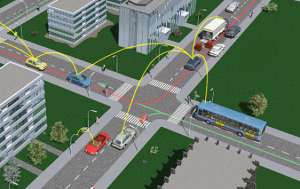Intelligent transportation systems are projects that aim to integrate modern communication and information technology into existing transportation management systems in order to optimize vehicle life, fuel efficiency, safety, and traffic in urbanized cities.
The need for intelligent transportation systems stems from the fact that traffic congestion has been increasing all around the world because of increasing population, increasing amount of transportation vehicles and increasing urbanization.
Wireless Technologies
Wireless communication technologies have been proposed, tested and used for intelligent transportation systems. From the short-range communications systems like WAVE or IEEE 802.11 protocol to the range extended by utilizing mesh networking or mobile ad hoc networks, many possibilities exist. Long-range communications systems like GSM or WiMAX which are far more expensive and complicated have also been proposed.
Computational Systems
The installation of operational systems and processors in transportation vehicles have also allowed software applications and artificial intelligence systems to be installed. These systems include internal control of model based processes, ubiquitous computing and other programs designed to be integrated into a greater transportation system.
Floating Car Data or FCD
Floating car data on the other hand makes use of the availability of location data garnered from mobile phones by the network carriers. Since this data is updated constantly throughout the day, they can be used as traffic probes showing points where there is traffic congestion, the average traffic speed and traffic direction. Moreover, since this system requires no costly infrastructures and equipment like cameras or sensors and is not affected by adverse weather, it is one of the strongest contenders for intelligent transportation systems.
Sensing Technologies
Sensing technologies involve embedding sensors along the road or the surrounding infrastructure like traffic posts, signs and buildings. These sensors include inductive loops that can sense the vehicles’ speed, the number of vehicles passing as well as the size of these vehicles. Video detection, on the other hand, involves the installation of video cameras onto road structures such as poles or billboards to detect occupancy information on the lanes, vehicle speeds, vehicles heading the wrong way, etc.
Applications of Intelligent Transportation Systems
Automatic Toll Collection
Intelligent transport systems are used for automatic toll collection where the vehicles can pass through without slowing down. This eliminates choke points along routes having toll booths and enforces cordon zones in some cities. Automatic toll collection systems make use of radio devices, infrared systems, RFIDs, license plate recognition systems and barcode stickers.
Vehicle Notification Systems
Intelligent transport systems particularly the FCD model can also be used to provide advance warning to motorists of traffic jams, accidents and other emergency situations. This system can then provide alternative routes or recommendations to motorists so as to avoid congestion and travel delays.
Cordon Zones
With the intelligent transportation system, cordon zones can also be enforced where mass transportation systems are available and their use encouraged. Cordon systems make it possible to collect taxes from those entering city areas with high traffic while encouraging the use of mass transit.
Filed under: Intelligent Transportation System | Tagged: Intelligent transportation system |


I love this website, the information is great and I have bookmarked it in my favorites. This is a well organized and informative website. Great Job!
Thanks
thats fine write up. can you help me with more details and costing for its
Yes sure
I am a PhD student in Sweden. I really liked the photo that you used to describe ITS, so I was wondering do I have a permission to use it in my report? I can reference to this website or whatever way you prefer
Yes sure
Hello Web Admin, I noticed that your On-Page SEO is is missing a few factors, for one you do not use all three H tags in your post, also I notice that you are not using bold or italics properly in your SEO optimization. On-Page SEO means more now than ever since the new Google update: Panda. No longer are backlinks and simply pinging or sending out a RSS feed the key to getting Google PageRank or Alexa Rankings, You now NEED On-Page SEO. So what is good On-Page SEO?First your keyword must appear in the title.Then it must appear in the URL.You have to optimize your keyword and make sure that it has a nice keyword density of 3-5% in your article with relevant LSI (Latent Semantic Indexing). Then you should spread all H1,H2,H3 tags in your article.Your Keyword should appear in your first paragraph and in the last sentence of the page. You should have relevant usage of Bold and italics of your keyword.There should be one internal link to a page on your blog and you should have one image with an alt tag that has your keyword….wait there’s even more Now what if i told you there was a simple WordPress plugin that does all the On-Page SEO, and automatically for you? That’s right AUTOMATICALLY, just watch this 4minute video for more information at. Seo Plugin